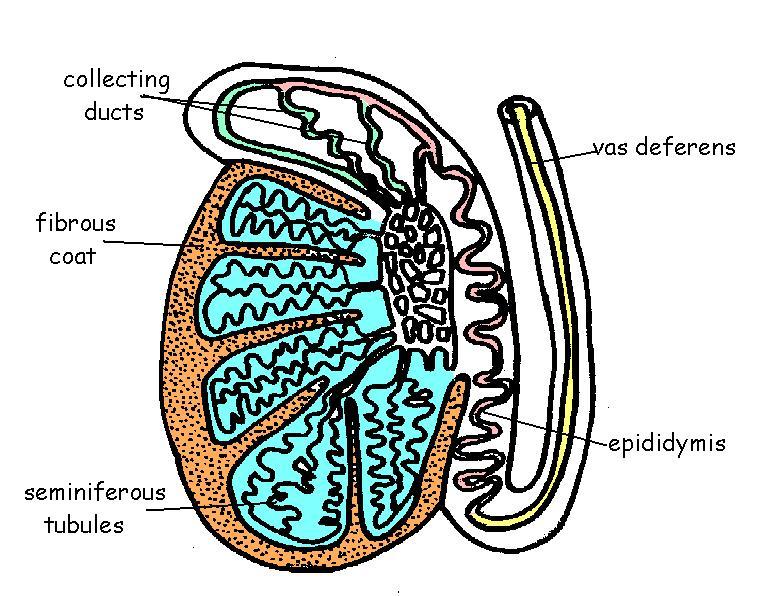MALE REPRODUCTIVE SYSTEM
SCROTUM - The scrotum is a sac like organ made of skin and muscles that houses the testes.
It is located inferior to the penis in the pubic region.
The scrotum is made up of 2 side by side pouches with a testis located in each pouch.
The smooth muscles that make up the scrotum allow it to regulate the distance between the testes and the rest of the body.
When the testes become too warm to support spermatogenesis, the scrotum relaxes to move the testes away from the body's heat.
Conversely, the scrotum contracts to move the testes closer to the body's core heat when temperature drop below the ideal range for spermatogenesis.
TESTES- The 2 testes, also known as testicles, are the male gonads responsible for the production of sperm and testosterone.
The testes are ellipsoid glandular organs around 1.5 to 2 inches long and an inch in diameter.
Each testis is found inside its own pouch on one side of the scrotum and is connected to the abdomen by the spermatic cord and cremaster muscle.
The cremaster muscles contract and relax along the scrotum to regulate the temperature of the testes.
The inside of the testes is divided into small compartments known as lobules.
Each lobule contains a section of seminiferous tubule lined with epithelial cells.
These epithelial cells contain many stem cells that divide and form sperm cells through the process of spermatogenesis.
EPIDIDYMIS- The epididymis is a sperm storage area that wraps around the superior and posterior edge of the testes.
The epididymis is made up of several feet long, thin tubules that are tightly coiled into a small mass.
Sperm produced in the testes move into the epididymis to mature before being passed on through the male reprouctive organs.
The length of the epididymis delays the release of the sperm and allows them time to mature.
SPERMATIC CORDS AND DUCTUS DEFERENS - Within the scrotum , a pair of spermatic cords connects the testes to the abdominal cavity.
The spermatic cords contain the ductus deferens along with nerves, veins, arteries and lymphatic vessels that support the function of the testes.
The ductus deferens, also known as vas deferens, is a muscular tube that carries sperm superiorly from the epididymis into the abdominal cavity to the ejaculatory duct.
The ductus deferens is wider in diameter than the epididymis and uses its internal space to store mature sperm.
The smooth muscles of the walls of the walls of the ductus deferens are used to move sperm towards the ejaculatory duct through peristalsis.

Structure of testis
SEMINAL VESICLES - Pair of glands that store and produce some of the liquid portion of semen.
The seminal vesicles are about 2 inches in length and located posterior to the urinary bladder and anterior to the rectum.
The liquid produced by the seminal vesicles contains proteins and mucus and has an alkaline pH to help sperm survive in the scidic environment of the vagina.
The liquid also contains fructose to feed sperm cells so that they survive long enough to fertilize the ovum.
EJACULATORY DUCT - The ductus deferens passes through the prostate and joins with the urethra at the structure known as ejaculatory duct.
The ejaculatory duct contains the ducts from the seminal vesicles as well.
During ejaculation, the ejaculatory duct opens and expels sperm and the secretions from the seminal vesicles into the urethra.
URETHRA- Semen passes from the ejaculatory duct to the exterior of the body via the urethra an 8 to 10 inch long muscular tube.
The urethra passes through the prostate and ends at the external urethral orifice located at the tip of the penis.
Urine exiting the body from the urinary bladder also passes through the urethra.
PROSTATE GLAND - The prostate is a walnut shaped gland that borders the inferior end of the urinary bladder and surrounds the urethra.
The prostate produces a large portion of the fluid that makes up semen.
This fluid is milky white in color and contains enzymes, proteins and other chemicals to support and protect sperm during ejaculation.
The prostate also contains smooth muscle tissue that can construct to prevent the flow of urine or semen.
COWPER'S GLAND - The cowper's glands is also known as bulbourethral glands, are a pair of pea- sized glands located inferior to the prostate and anterior to the anus.
The cowper's glands secrete a thin alkaline fluid into the urethra that lubricates and neutralizes acid from the urine remaining in the uretra after urination.
This fluid enters the urethra during sexual arousal prior to ejaculation to prepare the urethra for the flow of semen.
PENIS- The penis is the male external sexual organ located superior to the scrotum and inferior to the umbilicus.
The penis is roughly cylindrical in shape and contains the urethra and the external opening of the urethra.
Large pockets of erectile tissue in the penis allow it to fill with blood and become erect.
The erection of the penis causes it to increase in size and become turgid.
The function of the penis is to deliver semen into the vagina during sexual intercourse.
In addition to its reproductive function, the penis also allows for the excretion of urine through the urethra to the exterior of the body.

MALE REPRODUCTIVE SYSTEM
Through this video you will understand male reproductive system better
*thankyou*
*do give your suggestions *

Good work shradha
ReplyDeleteThnx bro
ReplyDelete